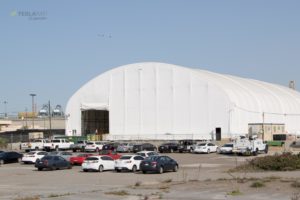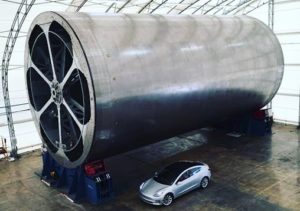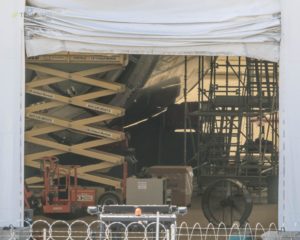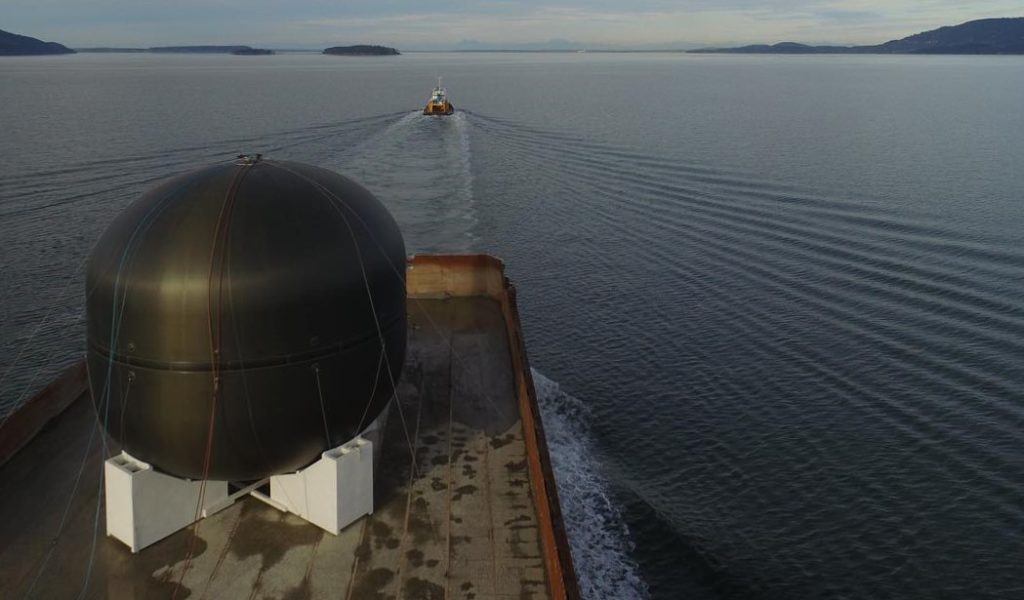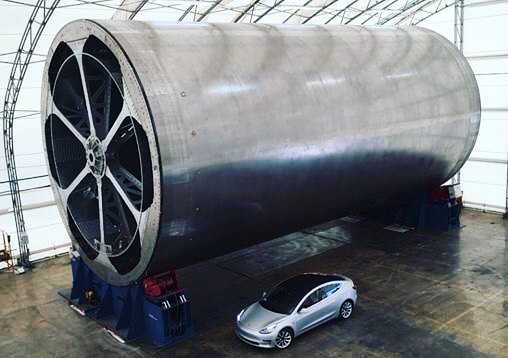

News
SpaceX posts first BFR-dedicated job posting – wanna build a Mars rocket?
SpaceX has published the first job posting specifically dedicated to BFR, the company’s ambitious fully-reusable Mars rocket and multipurpose launch vehicle. Currently targeting the first half of 2019 for initial hop tests with a prototype spaceship (upper stage) and 2020 for the first full-up orbital tests of the booster and ship. Job postings specific to BFR signify the beginning of serious R&D expansion and acceleration.
Since its announcement in September 2017, SpaceX has made slow but steady (visible) progress on its path to integrated BFR prototype production, including the construction of a giant temporary tent, the successful lease of a large plot of land intended to support the first dedicated BFR factory at Port of Los Angeles, and accepted shipments of massive tooling that will be used to construct the huge rocket’s first carbon composite propellant tanks.
- Lots of cars at the BFR tent. This also provides a sense of scale for the tent’s absolutely massive access flaps. (Pauline Acalin)
- SpaceX’s first major BFR and BFS fabrication tooling, likely being stored temporarily in a tent at Port of San Pedro. Note the tent framework at the top. (Elon Musk)
- Images corroborated the location of the giant mandrel tool inside the Port of San Pedro tent, April 2018. (Pauline Acalin)
First revealed in 2016 in the form of the 33% larger Interplanetary Transport System (ITS), CEO Elon Musk provided a second update in 2017 that showed an optimized, smaller rocket with all the same goals, known as BFR (Big F- Rocket). The rocket’s main propulsion, a methane and liquid oxygen-fueled engine known as Raptor, also saw its 2016 targets lowered partially, dropping its targeted maximum thrust to about double (from 3000 kN to 1700 kN) the current Merlin 1D engines powering the Falcon family.
Tellingly, the job posted on Monday, June 11, sounds very similar to those posted for equivalent engineering positions with Falcon 9 and Dragon. Titled “BFR Build Engineer”, the listing describes many of the same skills and tasks prospective employees would expect to find if hired, with most focused on SpaceX’s culture of constant improvement. The same is expected from build engineers and engineers, in general, focused on SpaceX’s current operational launch vehicles and spacecraft, strongly suggesting that the BFR effort is taking its very first steps from an experimental research program to something more akin to an operational branch of the launch company.
What is definitely new is the specific focus on expertise with advanced forms of welding, particularly with joining distinct composite and metal components, as will be required throughout BFR.
- SpaceX’s subscale Raptor engine has completed more than 1200 seconds of testing in less than two years. (SpaceX)
- Shown here is a prototype of the original 12m diameter ITS tankage. BFR’s tanks will be 25% narrower, and thus easier to manufacture. (SpaceX)
Read the best parts of the job listing below:
“The BFR (Big Falcon Rocket) is a massive next generation launch vehicle and spacecraft designed to carry [hu]mankind to the moon, Mars, and beyond. Also capable of flying humans from Los Angeles to New York in 25 minutes, the BFR will eventually replace the current Falcon 9, Falcon Heavy, and Dragon programs as the primary vehicle for all SpaceX missions.”
“The goal of this team is to investigate, test, and develop new hardware, software, and automation efforts capable of supporting advanced metallic and composite joining methods for the BFR. Focusing on friction stir welding, EB [electron-beam] welding, and composite tank lamination, the BFR Build Engineer is responsible for delivering results on critical projects with a highly demanding and fast-paced schedule”
- Drive the technology development for manufacturing cryogenic composite tanks through research, mechanical/destructive testing and sub-scale manufacturing
- Work closely with vehicle analysts and manufacturing team to ensure solutions meet the requirements for vehicle design as well as the manufacturing processes
- Partner with engineering & production teams to generate ideas, designs, and improvements for current and next-generation vehicles
- Strong background in composite structures with knowledge of automated fiber placement, autoclaves and composite design criteria
News
Tesla launches in India with Model Y, showing pricing will be biggest challenge
Tesla finally got its Model Y launched in India, but it will surely come at a price for consumers.

Tesla has officially launched in India following years of delays, as it brought its Model Y to the market for the first time on Tuesday.
However, the launch showed that pricing is going to be its biggest challenge. The all-electric Model Y is priced significantly higher than in other major markets in which Tesla operates.
On Tuesday, Tesla’s Model Y went up for sale for 59,89,000 rupees for the Rear-Wheel Drive configuration, while the Long Range Rear-Wheel Drive was priced at 67,89,000.
This equates to $69,686 for the RWD and $78,994 for the Long Range RWD, a substantial markup compared to what these cars sell for in the United States.
🚨 Here’s the difference in price for the Tesla Model Y in the U.S. compared to India.
🚨 59,89,000 is $69,686
🚨 67,89,000 is $78,994 pic.twitter.com/7EUzyWLcED— TESLARATI (@Teslarati) July 15, 2025
Deliveries are currently scheduled for the third quarter, and it will be interesting to see how many units they can sell in the market at this price point.
The price includes tariffs and additional fees that are applied by the Indian government, which has aimed to work with foreign automakers to come to terms on lower duties that increase vehicle cost.
Tesla Model Y seen testing under wraps in India ahead of launch
There is a chance that these duties will be removed, which would create a more stable and affordable pricing model for Tesla in the future. President Trump and Indian Prime Minister Narendra Modi continue to iron out those details.
Maharashtra Chief Minister Devendra Fadnavis said to reporters outside the company’s new outlet in the region (via Reuters):
“In the future, we wish to see R&D and manufacturing done in India, and I am sure at an appropriate stage, Tesla will think about it.”
It appears to be eerily similar to the same “game of chicken” Tesla played with Indian government officials for the past few years. Tesla has always wanted to enter India, but was unable to do so due to these import duties.
India wanted Tesla to commit to building a Gigafactory in the country, but Tesla wanted to test demand first.
It seems this could be that demand test, and the duties are going to have a significant impact on what demand will actually be.
Elon Musk
Tesla ups Robotaxi fare price to another comical figure with service area expansion
Tesla upped its fare price for a Robotaxi ride from $4.20 to, you guessed it, $6.90.

Tesla has upped its fare price for the Robotaxi platform in Austin for the first time since its launch on June 22. The increase came on the same day that Tesla expanded its Service Area for the Robotaxi ride-hailing service, offering rides to a broader portion of the city.
The price is up from $4.20, a figure that many Tesla fans will find amusing, considering CEO Elon Musk has used that number, as well as ’69,’ as a light-hearted attempt at comedy over the past several years.
Musk confirmed yesterday that Tesla would up the price per ride from that $4.20 point to $6.90. Are we really surprised that is what the company decided on, as the expansion of the Service Area also took effect on Monday?
But the price is now a princely $6.90, as foretold in the prophecy 😂
— Elon Musk (@elonmusk) July 14, 2025
The Service Area expansion was also somewhat of a joke too, especially considering the shape of the new region where the driverless service can travel.
I wrote yesterday about how it might be funny, but in reality, it is more of a message to competitors that Tesla can expand in Austin wherever it wants at any time.
Tesla’s Robotaxi expansion wasn’t a joke, it was a warning to competitors
It was only a matter of time before the Robotaxi platform would subject riders to a higher, flat fee for a ride. This is primarily due to two reasons: the size of the access program is increasing, and, more importantly, the service area is expanding in size.
Tesla has already surpassed Waymo in Austin in terms of its service area, which is roughly five square miles larger. Waymo launched driverless rides to the public back in March, while Tesla’s just became available to a small group in June. Tesla has already expanded it, allowing new members to hail a ride from a driverless Model Y nearly every day.
The Robotaxi app is also becoming more robust as Tesla is adding new features with updates. It has already been updated on two occasions, with the most recent improvements being rolled out yesterday.
Tesla updates Robotaxi app with several big changes, including wider service area
News
Tesla Model Y and Model 3 dominate U.S. EV sales despite headwinds
Tesla’s two mainstream vehicles accounted for more than 40% of all EVs sold in the United States in Q2 2025.

Tesla’s Model Y and Model 3 remained the top-selling electric vehicles in the U.S. during Q2 2025, even as the broader EV market dipped 6.3% year-over-year.
The Model Y logged 86,120 units sold, followed by the Model 3 at 48,803. This means that Tesla’s two mainstream vehicles accounted for 43% of all EVs sold in the United States during the second quarter, as per data from Cox Automotive.
Tesla leads amid tax credit uncertainty and a tough first half
Tesla’s performance in Q2 is notable given a series of hurdles earlier in the year. The company temporarily paused Model Y deliveries in Q1 as it transitioned to the production of the new Model Y, and its retail presence was hit by protests and vandalism tied to political backlash against CEO Elon Musk. The fallout carried into Q2, yet Tesla’s two mass-market vehicles still outsold the next eight EVs combined.
Q2 marked just the third-ever YoY decline in quarterly EV sales, totaling 310,839 units. Electric vehicle sales, however, were still up 4.9% from Q1 and reached a record 607,089 units in the first half of 2025. Analysts also expect a surge in Q3 as buyers rush to qualify for federal EV tax credits before they expire on October 1, Cox Automotive noted in a post.
Legacy rivals gain ground, but Tesla holds its commanding lead
General Motors more than doubled its EV volume in the first half of 2025, selling over 78,000 units and boosting its EV market share to 12.9%. Chevrolet became the second-best-selling EV brand, pushing GM past Ford and Hyundai. Tesla, however, still retained a commanding 44.7% electric vehicle market share despite a 12% drop in in Q2 revenue, following a decline of almost 9% in Q1.
Incentives reached record highs in Q2, averaging 14.8% of transaction prices, roughly $8,500 per vehicle. As government support winds down, the used EV market is also gaining momentum, with over 100,000 used EVs sold in Q2.
Q2 2025 Kelley Blue Book EV Sales Report by Simon Alvarez on Scribd
-

 News3 days ago
News3 days agoTesla debuts hands-free Grok AI with update 2025.26: What you need to know
-

 Elon Musk1 week ago
Elon Musk1 week agoElon Musk confirms Grok 4 launch on July 9 with livestream event
-

 Elon Musk5 days ago
Elon Musk5 days agoxAI launches Grok 4 with new $300/month SuperGrok Heavy subscription
-

 News2 weeks ago
News2 weeks agoTesla Model 3 ranks as the safest new car in Europe for 2025, per Euro NCAP tests
-

 Elon Musk2 weeks ago
Elon Musk2 weeks agoxAI’s Memphis data center receives air permit despite community criticism
-

 News5 days ago
News5 days agoTesla begins Robotaxi certification push in Arizona: report
-

 Elon Musk2 weeks ago
Elon Musk2 weeks agoTesla reveals it is using AI to make factories more sustainable: here’s how
-

 Elon Musk2 weeks ago
Elon Musk2 weeks agoTesla scrambles after Musk sidekick exit, CEO takes over sales

